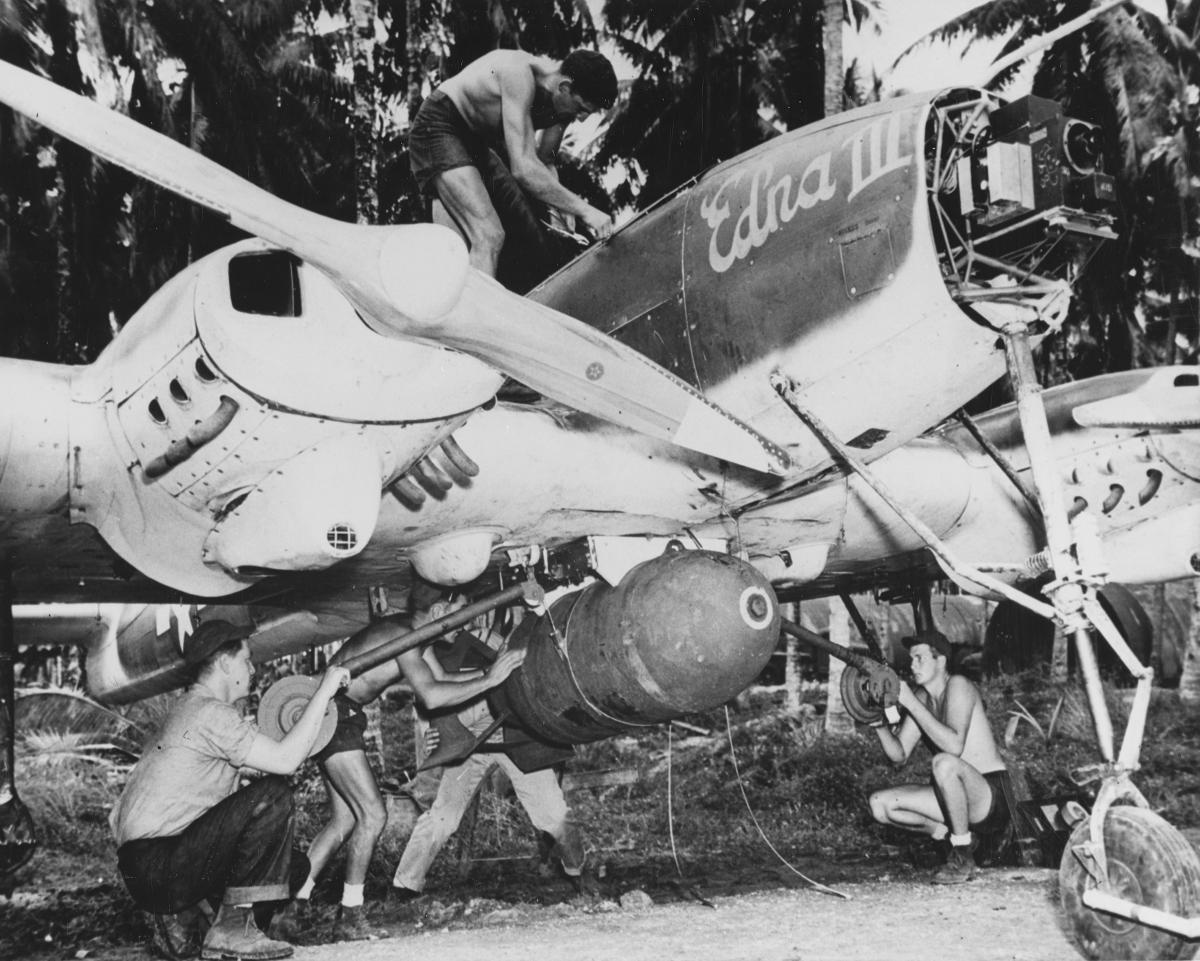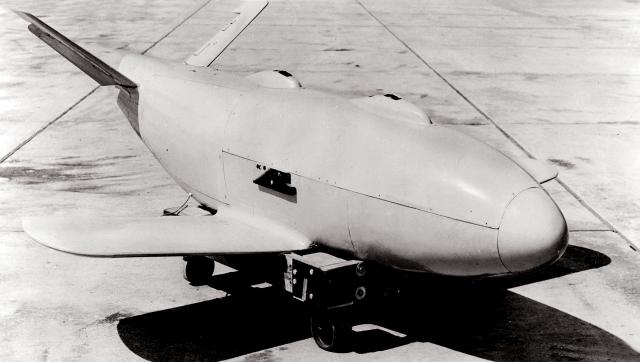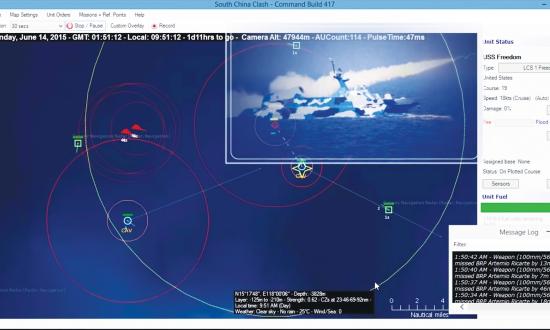The Navy is pushing into unmanned systems in a big way, simultaneously developing unmanned aerial systems (UASs and UAVs) that can operate thousands of miles from friendly forces, as well as ships (USVs) and undersea craft (UUVs) that can operate autonomously for weeks at a time. But the Navy’s interest in unmanned systems is nothing new—it stretches back more than a century.
In 1917, Dr. Peter Cooper and Elmer A. Sperry invented the automatic gyroscopic stabilizer. The stabilizer helped keep an aircraft flying straight and level, a key autopilot feature that made unmanned aircraft a viable possibility. The Sperry Corporation conducted a number of experiments on behalf of the Bureau of Ordnance, pairing a Curtiss N-9H trainer aircraft, a gyroscopic stabilizer, and 300 pounds of explosives to create what it called the “aerial torpedo.” The Navy called it simply the “Flying Bomb.”
The Flying Bomb took off like a normal plane and counted propeller revolutions to estimate distance to target. It had a top speed of 90 miles per hour and a range of 50 miles. The N-9 was accurate enough for the Navy to order more for tests, but a series of crashes doomed the program, and development ended without the world’s first cruise missile ever seeing combat.
The 1930s saw another attempt to create remote-controlled aerial weapons. On 14 September 1938, an unpiloted Curtiss N2C-2 Fledgling dove onto a target ship, the ex-Utah (AG-16). The N2C-2 was guided to the target visually and controlled by radio signals. Although a success, the program did not lead to an operational weapon system—at least not right away. The U.S. Navy first used the term “drone” during this period of experimentation to refer to an unmanned aircraft, a term still in use today.
In 1937, Dr. V. K. Zworykin of the RCA Corporation petitioned the Navy to create an aircraft-derived guided weapon. This resulted in the Navy ordering the modification of a Great Lakes TG-2/Martin T4M torpedo plane into an unmanned torpedo bomber. The plane and weapon release were controlled by radio frequency at a distance of up to 1.5 miles. The program was successful enough that the Navy assigned 100 obsolete torpedo planes to it, but the mobilization that followed the Japanese attack on Pearl Harbor made every available plane necessary. The unmanned torpedo bomber program halted.
In June 1941, the Navy began looking at another unmanned system, what it called an “aerial ram.” This was to be a remote-controlled fighter jet that would fly into bomber formations in midair and ram into an attacking aircraft. The program quickly hit a wall of technical issues, primarily regarding remote control of the weapon in combat, and it languished until 1945, when it was resurrected in the form of the Gorgon air-to-air missile.
A wartime program to build remote controlled carrier-based attack aircraft gained slightly better traction. Project Option envisioned drones filled with explosives and controlled from other carrier-based aircraft from afar. This was seen as more realistic than earlier efforts, as the drone would not outrun a ship-based controller and risk severing radio links. Project Option was ambitious and promised to save lives: Naval aviators would not need to run a gantlet of enemy antiaircraft fire to deliver their ordnance, sending a drone to attack the target instead.
Unfortunately, Option ran up against competing wartime demands. The military was expanding in all directions, placing orders for thousands of tanks, armored vehicles, aircraft, and ships of all kinds. Plans for as many as 300 drones of a new, untested type per month were too ambitious, and there was little industrial capacity for experimentation. The order was reduced to just 500 total.
One of the most vexing technical dilemmas was how to make a drone detect a target and release a weapon. Engineers at RCA came up with a solution, the Airborne Radar Low Altitude Bomb Release, Automatic, known variously as the RL-101 “Sniffer” and the AN/APG-4 UHF radar. The system, derived from a radar altimeter, allowed a drone to locate its target in the forward arc, while the radar antenna oscillated left and right to give it a wider seeking capability. A drone equipped with the Sniffer would travel in the direction of the target at a constant speed and altitude. Once the radar located the target, the drone could then release its bombs at a distance calculated to hit.
The first drones, designated TDN-1s, were put through their paces in 1943. According to History of Electronics Communications in the U.S. Navy, Project Option’s drones were “superior to a gun, bomb, torpedo in accuracy” and could hit targets in a horizontal approach that “couldn’t be reached by other weapons.” Testers recommended that the weapons, guided by radar that could see through adverse weather, be used “during periods of low visibility” to catch the enemy by surprise. By 1944, the Office of the Chief of Naval Operations recognized problems with controlling them from carrier aircraft, and the program stalled.
A second, more successful drone under Project Option was the Interstate TDR-1 Assault Drone. The TDR-1 was equipped with a television camera and guided by joystick to the target, controlled by an aviator in a modified TBM Avenger. Under control of the Navy’s Special Task Air Group One (STAG-1), TDR-1s and Avengers carried out a series of successful strikes in fall 1944, delivering 2,000 bombs against Japanese targets in New Guinea. Despite a claimed 50-percent success rate in combat, the Navy did not follow up on the success of the TDR-1, ending the experiment in late October 1944.
The Navy’s interwar and wartime development of unmanned combat systems was constrained by the technology of the time. Early radio lacked the range to control drones from more than four or five miles, meaning the radio—and, therefore, the human operator—had to fly nearby in a separate aircraft. Although engineers developed radar-based target-sensing systems, the systems could detect only one target on the ground, not discriminate one among many. To do that, a human spotter had to guide the drone. The TDR-1’s television solution was prone to screen failure, causing the operator to lose situational awareness and control.
The range limitations fundamentally shaped how the Navy looked at unmanned systems. Unable to fly any meaningful distance on their own, the unmanned craft became smaller and were carried underneath manned aircraft. As rocket technology matured, these unmanned craft developed ever more quickly, flying faster even than the aircraft that carried them. The limits of contemporary technology forced unmanned systems to evolve into something completely new: The guided missile was born.
Most of today’s missiles draw a direct line to craft developed by the Navy in the early 20th century. The Flying Bomb was a primitive cruise missile, the forebear of the Tomahawk land-attack missile. The N2C-2, as an unguided ramming plane, is the forerunner of air-to-air weapons such as the AIM-7 Sparrow and AIM-9 Sidewinder families of missiles. The TV transmitter in the TDR-1 eventually led to the AGM-65 Maverick missile. The Navy’s wartime policy of sponsoring many unmanned programs to see if any would “stick to the wall” paid dividends over a very long time.
The Navy’s recent drive into UAVs such as the MQ-25A Stingray, UUVs such as Boeing’s Orca, and USVs such as the Large Unmanned Surface Vessel are possible only thanks to modern, long-range, secure communications. Unlike the unmanned aircraft in the first half of the 20th century, these vehicles may emerge as true analogs for their manned versions. The innovations they will birth will be new tactics, greater flexibility, and—ultimately—a pawn to sacrifice for a queen. The designers of the TG-2 would likely agree.
H. R. Everett, Unmanned Systems of World Wars I and II (Cambridge, MA: The MIT Press, 2015).
Louis A. Gebhard, Evolution of Naval Radio-electronics and Contributions of the Naval Research Laboratory (Berkeley, CA: University of California Press, 1979).
Ben Werner, “Navy Awards Boeing $43 Million to Build Four Orca XLUUVs,” USNI News, 17 April 2019.
U.S. Department of Commerce, “Bibliography of Scientific and Industrial Reports,” 3 May 1946.
Linwood S. Howeth, History of Communications Electronics in the United States Navy (Office of Naval History, 1963).
Pacific Wrecks, “Special Task Air Group One,”
www.pacificwrecks.com/units/usn/stag-1/index.html.







